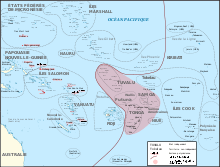Polynesian outlier

Polynesian outliers are a number of culturally Polynesian societies that lie outside the main region of Polynesian influence, known as the Polynesian Triangle; instead, Polynesian outliers are scattered in the two other Pacific subregions: Melanesia and Micronesia. Based on archaeological and linguistic analysis, these islands are considered to have been colonized by seafaring Polynesians, mostly from the area of Tonga, Samoa and Tuvalu.
General definition
The region commonly termed "Polynesia" includes thousands of islands, most of them arranged in a rough triangle bounded by Hawaii, Easter Island, and New Zealand. Outside the Polynesian Triangle, in areas commonly designated Micronesia and Melanesia, lie about two dozen islands, most of them small and widely separated, whose inhabitants speak Polynesian languages. These islands are collectively termed the Polynesian "outliers".
Their residents generally share features found within Triangle Polynesia. Physically, Polynesians tend to have brown complexions and dark, wavy hair, and they are typically large people of muscular build.
The fact that people in all of the Polynesian outliers speak recognizably Polynesian languages implies that their ancestors fairly recently migrated from the Polynesian heartland. Yet there is much social variation. In some places, outlier populations settled in close proximity to Melanesian or Micronesian populations and seem to have been influenced by them. In other locations, outlier populations remained isolated by geography, ecology, or choice and seem more classically Polynesian.[1]
Geography

Polynesian outlier cultures are scattered across five countries of the Pacific: in the Federated States of Micronesia, in Papua New Guinea, in the Solomon Islands, in Vanuatu, and in New Caledonia.
The Federated States of Micronesia has two outlier cultures, Kapingamarangi and Nukuoro. Papua New Guinea has four : Nuguria, Nukumanu, and Takuu Vu'ula or Hula. The country with the most outlier cultures is the Solomon Islands, with seven: Anuta, Bellona, Ontong Java, Rennell, Sikaiana, Tikopia, and Vaeakau-Taumako. Vanuatu has three: Emae, Makura, Mele (Erakoro, Eratapu) stemming from Rarotonga, (Aniwa) and Futuna. Futuna recognizes links with Tonga. The principal outlier culture in New Caledonia is on Ouvéa in the Loyalty Islands, where the Fagauvea language is spoken.
The links of these people are multiple. [2]
Language
The outlier groups in Micronesia, Papua New Guinea, and the northern Solomon Islands speak Ellicean languages (which also includes Tuvaluan), while those further to the south in the Solomons, Vanuatu, and New Caledonia speak Futunic languages (which also includes the language of Wallis and Futuna). These are two of the branches of the Samoic language family, which is sometimes called the Samoan-Outlier language family for this reason. It is a sub-branch of the Nuclear Polynesian languages. In some of these islands, the outlier population may also speak the local Melanesian or Micronesian language.
Genetics
A 1983 study analyzing the DNA of 2400 people in the Solomon Islands and Vanuatu have found markers which clearly distinguish the Polynesian outlier islands of the group. Of the four Polynesian outliers considered, Anuta was the most genetically distinct, followed by Rennell and Bellona. Tikopia showed more influence from the nearby Melanesian population. All indicate traces of inter-island population movements, and even sources from Europeans, Africans, and Asians, though the latter were at a low level.[3]
References
- ↑ Feinberg, Richard and Richard Scaglion, eds. 2012. Polynesian Outliers: The State of the Art. Ethnology Monographs, No. 21. Pittsburgh: University of Pittsburgh Press.
- ↑ They come from Tonga, Samoa, Rarotonga, and the Wallis and Futuna islands. There are groups of Polynesian descent dispersed on the east coast of New Caledonia (Balade, Pouébo). One has even crossed over the centuries from the east coast at Houaïlou to the west coast at Bourail. There is a Polynesian group (from Wallis islands) on South Lifou and one on the coast, coming from Rarotonga. The present inhabitants of Rennell and Bellona have come by way of Ouvéa. Those of Taumako have come from the Ellice islands, as well as part of the inhabitants of Tikopia. There are descendants of the crews of Samoan canoes on Tongoa, Tongariki and Makura in the Shepherds' islands.
- ↑ Blake, N.M.; Hawkins, B.R.; Kirk, R.L.; Bhatia, K.; Brown, P.; Garruto, R.M.; Gajdusek, D.C. (December 1983). "A population genetic study of the Banks and Torres Islands (Vanuatu) and of the Santa Cruz Islands and Polynesian Outliers (Solomon Islands)". American Journal of Physical Anthropology. 62 (4): 343–61. PMID 6607679. doi:10.1002/ajpa.1330620402.